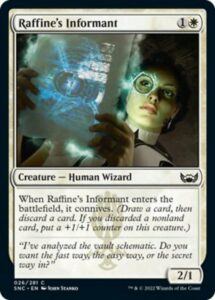This weekend, for the first time in years, paper prerelease was the only way to experience the set. While it’s been great having the option to play on Magic Arena when it wasn’t safe or easy to play in person; for me, there’s no substitute for the feel of opening a real pack, the experience of sitting around a table drafting with friends, or the sharp snap of a flicking hand of cards. I was fortunate enough to sneak into a prerelease event and get in two team drafts with friends. So, while I’m far from being any sort of expert in Streets of New Capenna Limited, I did have the chance to put some of my guesses to the test and learn a few things about the format.
Today, I’d like to share what I know so far about the format. There are many, many more drafts to be done, but the decks I’ve played with and against have provided some small bit of foundation upon which to examine the format.
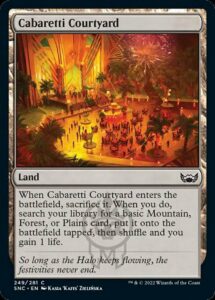
Mana fixing
The fixing in the set seems pretty excellent. Having an entire cycle of common Evolving Wilds makes it so, so much easier to splash or play the intended tricolor decks. And the fact that it’s a cycle of five means a large number of this effect will appear in every draft. The addition of a second cycle of allied lands like Racers’ Ring further enables good mana while also helping mitigate mana flooding. Ominous Parcel feels like more a Sealed card than a Draft mainstay, but I was impressed by its ability to play two vital roles. And finally, for those desperate, there’s a seemingly unimpressive cycle of expensive fixers like Glamorous Outlaw.
The sheer volume of fixing, all of which ranges from playable to outstanding, does a lot to help keep games from being decided by color problems. However, the fact that every piece of fixing involves a speed bump also opens the door up to more streamlined, two color decks.
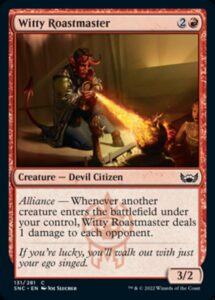
The tricolor family mechanics
As expected, the set’s mechanics are very Spike-y. Blitz, Connive, and Casualty are defined by making correct decisions based on evaluations of the battlefield, the flow of the game, and the contents of your hand and deck. Alliance struck me as a simple mechanic with a simple deckbuilding challenge, but I’ve found it able to be surprisingly taxing to execute (Gala Greeters + Stimulus Package + other Alliance cards). And then there are Shield Counters, which are simple, strong, and to me, a bit dull.
Thus far, I’ve been underwhelmed by Connive and Casualty. Connive is an inherently strong mechanic by virtue of being card smoothing, but there doesn’t feel to be many ways to generate value beyond the +1/+1 counter or the loot. It simply is exactly what it appears to be, and that’s Explore with less power and more agency. On the other hand, Casualty seems to have plenty of ways to generate additional value, but most Casualty spells need to generate additional value to really justify the loss of board presence.
Blitz has drastically overperformed my expectations in both power and shenanigans. As with Casualty, there are so many ways to make it more than the sum of its parts. Unlike Casualty, the floor is high enough that you don’t need to, especially if you build your deck at all aggressively. With Blitz and Alliance, I feel like the design team did an excellent job giving green and red decks interesting shenanigans to play with when they’re normally the most straightforward color combinations. Unfortunately, I haven’t been nearly as excited about the three other families’ mechanics.
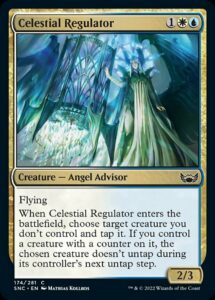
The allure of two colors
Way back in Khans of Tarkir, you generally wanted to start by drafting of the five enemy color pairs. This gave you some flexibility at the draft table, since you could end up in two clans (for example, a black-green drafter could end up in Abzan or Sultai, while a blue-black drafter could only end up in Sultai). Streets of New Capenna has the same set structure as Khans and the same incentives.
Thus far, I haven’t felt the same pull into tricolors in SNC as I did in KTK. The most impressive decks I’ve seen were two color decks with a light splash (thanks to SNC’s excellent mana fixing). Many of the highest power level commons are the one and two color commons Inspiring Overseer, Mayhem Patrol, Jewel Thief, and Celestial Regulator. These are high power level cards that aren’t reliant on synergy, unlike what many of the families offer. Add in that many of the mechanics and tricolor commons just don’t seem as strong to me and you have the makings of a tricolor set that may well be dominated by two color decks.
Not all of the two color pairs have struck me as equal. The blue-black mechanic (having five different mana values) seems undersupported and hard to track. Red-green treasures have nothing to do with both Blitz and Alliance—they seem like a poor foundation to let you hedge your bets between two families. Green-white citizens is a random tribal mechanic that makes every creature’s type line matter (and because it’s a job tribal rather than a species tribal, it’s a lot harder to track). On the other hand, white-blue counters and black-red sacrifice—the two that have most impressed me—synergize perfectly with their two adjacent family mechanics and have access to strong monocolor and two color commons.
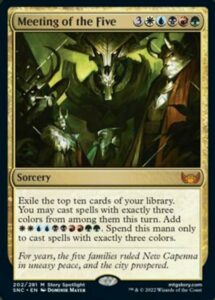
Salty soup
One of the biggest risks with multicolor sets, especially those that encourage 3+ color play, is the format devolving into multicolor soup. The best decks prioritize fixing, scoop up high power level (but fairly interchangeable) cards, and play fairly grindy games. The exact cards you use to win the game may change from draft to draft, but the texture of game you play is fairly consistent. I’d argue that both snow control in Kaldheim and blue goodstuff in Strixhaven feel afoul of this—I found them super sweet to play, but the decks blended into each other.
Thus far, I haven’t been impressed by a four- or five-color deck in Streets of New Capenna. The format is very, very new and I fully expect people to crack the archetype, but it hasn’t been as obvious as I thought it would be. Sure, the fixing is excellent, but each family is fairly dependent on synergy to function, and non-adjacent families play in very different manners. Many of the highest power level commons are monocolor, so they’re not going to go late around the table the way that a tricolor Ponyback Brigade would.
The scoop
While it’s too early in the format to make any pronouncements about how it’ll fare in the long term, it’s definitely been interesting playing a format so clearly built upon the structure as Khans of Tarkir. Khans is one of my favorite Limited formats of all time. I drafted a ton of it back in 2014 (which, somehow, was eight years ago).
Comparing the two sets, I can’t help but feel the absence of Morph. Morph was a sixth mechanic available to all five clans that provided texture, combat tension, and mana smoothing. There isn’t anything like that here. I recognize the irony of this concern coming from someone who complained that both Innistrad: Midnight Hunt and Innistrad: Crimson Vow had a sixth, unnecessary mechanic. However, I’m not sure if there will be enough to do. Maybe it’s not an issue given that there are five families and five allied color pairs, but I didn’t walk away from the weekend wowed by anything other than Blitz, and I was missing having a major mana sink like Morph that doubled as smoothing.
Of course, the format is young. We’ve still got a couple dozen drafts to do before making any real pronouncements about it, and I am looking forward to put in the reps.
And, as always, thanks for reading.
Zachary Barash is a New York City-based game designer and the last commissioner of Team Draft League. He designs for Kingdom Death: Monster, has a Game Design MFA from the NYU Game Center, and does freelance game design. When the stars align, he streams Magic (but the stars align way less often than he’d like).


